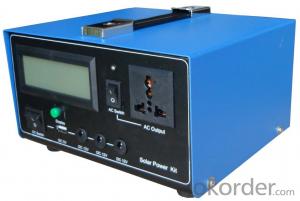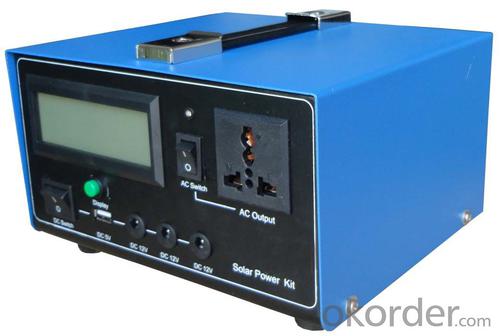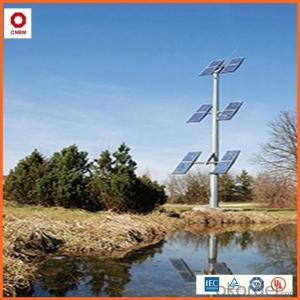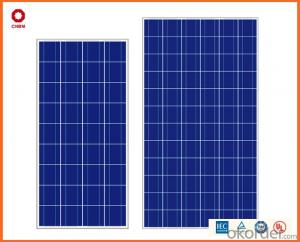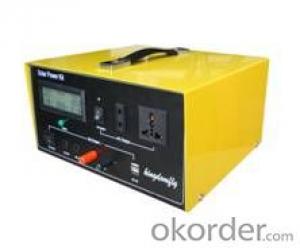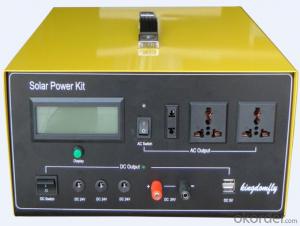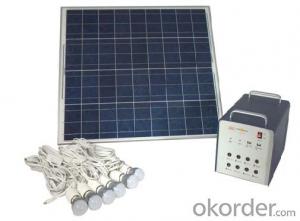Solar Energy Systems for Homes - SPK-300 LCD Solar Power System
- Loading Port:
- China main port
- Payment Terms:
- TT or LC
- Min Order Qty:
- 10 pc
- Supply Capability:
- 10000 pc/month
OKorder Service Pledge
OKorder Financial Service
You Might Also Like
A solar inverter, or PV inverter, or Solar converter, converts the variable direct current (DC) output of a photovoltaic (PV) solar panel into a utility frequency alternating current (AC) that can be fed into a commercial electrical grid or used by a local, off-grid electrical network.
It is a critical BOS–component in a photovoltaic system, allowing the use of ordinary AC-powered equipment.
Solar inverters have special functions adapted for use with photovoltaic arrays, including maximum power point tracking and anti-islanding protection.
Main Information
KDF SPK_300_LCD
This product is high performance, family used portable solar power system, which can receive energy and store it in battery outside connected to SPK by solar energy on sunny day, and supplies electric power for varies appliances such as electric fan, lighting lamps, television, portable computer etc.
It can supply power for both DC and AC electric application.
Main features:
◆ Battery puts outside connected to the SPK for user to choose battery in recommended range, and easily to exchange battery.
◆ Both DC and AC output
◆ Solar Feedback Circuit Protection
◆ Output Short-circuit Protection
◆ Solar「+」「-」anti-access protection
◆ Output「+」「-」anti-access protection
◆ Over Charged Protection
◆ Over Discharged Protection
◆ Over Load Protection
◆ Over-Temperature Protection
Technical parameters
Specification | Value/Material | |
Item No. KDF | SPK_300_LCD | |
Solar Recommended | Specification | Poly silicon |
Working Voltage/Power | 18V80W~120W | |
Battery Recommended | Rated Voltage/Capacity | 12V65AH~100AH |
Cycle Number | 80% Deep Cycle Number:500 70% Cycle Number:800 | |
Working Temperature | Short Period(one Month):-20~50℃ Long Period(Six Months):-10~45℃ | |
Charging Controller | Operating Voltage | 12V |
Input Voltage | 17.3V~21V | |
Input current | MAX:10A | |
Power Consumption | MAX: 5mA | |
Low Voltage Disconnect(LVD) | 10.8V | |
Low Voltage Reconnect(LVR) | 12.3V | |
High Voltage Discharge( HVC) | 14.6V | |
High Voltage Recharge(HVR) | 13.8V | |
Temperature Protection | 60℃ | |
DC Output | DC output & Application | USB 5V2A |
DC output & Application | DC 12V1*3A | |
AC Output | Output Wave | modified sine wave |
Input Voltage | 11V~15V | |
Output Voltage | 110V±10% | |
Output Frequency | 60Hz±2Hz/50Hz±2Hz | |
Rated Output Power | 300W | |
Maximum VA | 600VA | |
Maximum Efficiency | 88% | |
Temperature | 0-40℃ | |
Over Temperature | 60℃~70℃ | |
Low Voltage Alarm | 11V | |
Low Voltage Shut off | 10.5V | |
High Voltage Shut off | 16V | |
Package | Set size | 278*240*172mm |
Set N·W | 2.8kg | |
Set N·W | 3.6kg | |

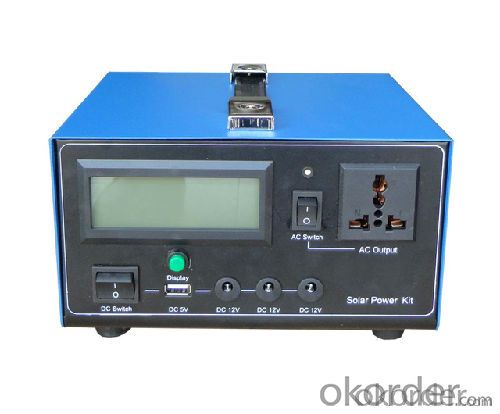
No. | Name | Function |
1 | Battery Icon | To show the Volume of the Battery |
2 | Date of % | To show the percent of the Battery |
3 | Charging Icon | To show the charging condition |
4 | Current | To show the value of charge current |
5 | Temperature Icon | Temperature Alarm |
6 | Date of Voltage | To Show the Value of DC output voltage |
7 | Date of Voltage | To Show the Value of AC output voltage |
8 | AC Icon | AC output |
9 | DC Icon | DC output |
This product can be used for any type of solar home systems. It has high conversion efficiency, reliable quality, intelligent monitoring system and best service, which will provide you with a memorable user experience and solutions.
- Q: How do solar energy systems impact the local economy?
- Solar energy systems can have a positive impact on the local economy in several ways. Firstly, the installation and maintenance of these systems create job opportunities, stimulating employment and income growth within the community. Additionally, the use of solar energy reduces reliance on imported fossil fuels, leading to energy cost savings for businesses and households. This, in turn, allows individuals and companies to allocate more resources towards other sectors of the economy and encourages local entrepreneurship. Finally, the development of solar energy infrastructure can attract investment and promote sustainable economic development, positioning the community as a leader in renewable energy technology.
- Q: Can solar energy systems be used in disaster relief efforts?
- Yes, solar energy systems can be used in disaster relief efforts. In fact, they have become increasingly popular and valuable in such situations. When disasters strike, they often disrupt the electricity supply, leaving affected areas without power for days or even weeks. This lack of electricity hampers relief efforts, making it difficult to provide basic necessities like lighting, medical care, communication, and clean water. Solar energy systems, on the other hand, can provide a reliable and sustainable source of power in these situations. They consist of solar panels that convert sunlight into electricity, which can be used to power various devices and appliances. These systems can be quickly deployed to disaster-stricken areas, providing immediate access to electricity without relying on traditional power grids. There are several advantages to using solar energy systems in disaster relief efforts. Firstly, solar power is renewable and abundant, ensuring a continuous supply of electricity even during prolonged emergencies. Secondly, solar energy systems are generally low maintenance, reducing the need for constant fuel supply or repairs. This makes them more cost-effective and reliable in disaster-prone areas. Solar energy systems can be used in a variety of ways during disaster relief efforts. They can power mobile charging stations, allowing people to charge their phones and stay connected with their loved ones. Solar-powered lighting can be used to illuminate temporary shelters, hospitals, and walkways, improving safety and security for victims and aid workers alike. Solar energy can also be used to power water purification systems, ensuring a supply of clean drinking water in areas where water infrastructure has been damaged or contaminated. Furthermore, solar energy systems can be integrated into existing relief infrastructure. For example, solar panels can be installed on the roofs of hospitals, schools, and community centers, ensuring a reliable source of electricity for critical operations. This reduces the dependence on diesel generators or other fossil fuel-powered alternatives, which are often expensive, noisy, and emit harmful pollutants. In summary, solar energy systems are highly beneficial in disaster relief efforts. They provide a sustainable and reliable source of power, enabling essential services and improving the overall relief operations. As the world faces more frequent and severe natural disasters, the use of solar energy systems in disaster relief will continue to grow in importance.
- Q: Can solar energy systems be used in areas with strict building codes or historical preservation restrictions?
- Yes, solar energy systems can be used in areas with strict building codes or historical preservation restrictions. While it may require some additional planning and design considerations, it is certainly possible to integrate solar energy systems into the existing structures in these areas. One way to incorporate solar energy systems is by using building-integrated photovoltaics (BIPV) or solar thermal systems that are seamlessly integrated into the building's design. These systems can be installed on rooftops, facades, or even as shading elements, ensuring that the historical aesthetics or architectural integrity of the building are not compromised. Furthermore, advancements in solar technology have allowed for the development of more visually appealing solar panels, such as solar tiles or transparent solar windows, which can blend in with the existing building materials. This makes it easier to gain approval from historical preservation boards or building code authorities. It is important to note that in areas with strict building codes or historical preservation restrictions, the approval process for installing solar energy systems may be more complex. It may require obtaining permits, conducting structural assessments, and working closely with local authorities to ensure compliance with regulations. However, with the growing recognition of the importance of renewable energy, many jurisdictions have developed specific guidelines and provisions for integrating solar systems in historic areas. In summary, solar energy systems can be used in areas with strict building codes or historical preservation restrictions by employing BIPV, solar thermal systems, or visually appealing solar panels. While the approval process may be more involved, with proper planning and adherence to guidelines, it is possible to harness solar energy without compromising the architectural or historical significance of the area.
- Q: Can solar energy systems be used for powering remote sensing or surveillance equipment?
- Yes, solar energy systems can be used for powering remote sensing or surveillance equipment. Solar panels can be installed to capture sunlight and convert it into electricity, which can then be used to power the equipment. This allows for a reliable and sustainable source of energy in remote locations where traditional power sources may be limited or unavailable. Additionally, solar energy systems are often low maintenance and can be easily deployed, making them an ideal choice for powering remote sensing or surveillance equipment.
- Q: Are there any ongoing monitoring requirements for solar energy systems?
- Yes, there are ongoing monitoring requirements for solar energy systems. Monitoring is essential to ensure that the solar energy system is operating efficiently and effectively. It helps in identifying any potential issues or malfunctions, allowing for timely repairs or maintenance. Ongoing monitoring typically involves tracking the system's performance, including energy production, system uptime, and any deviations from expected outputs. This can be done through various monitoring tools and technologies, such as real-time monitoring software, data loggers, or remote monitoring systems. Additionally, some jurisdictions or incentive programs may have specific monitoring requirements to ensure compliance with regulations or eligibility criteria. Regular monitoring helps maximize the benefits of solar energy systems and ensures their long-term performance and durability.
- Q: Can solar energy systems be used for powering off-grid eco-resorts?
- Yes, solar energy systems can indeed be used for powering off-grid eco-resorts. Solar power is a sustainable and renewable energy source that can provide a reliable and clean source of electricity even in remote locations. By installing solar panels and battery storage systems, off-grid eco-resorts can generate their own electricity, reducing their reliance on fossil fuels and minimizing their environmental impact. Additionally, solar energy systems can be easily scalable to meet the specific energy needs of eco-resorts, making them an ideal solution for off-grid power generation.
- Q: Are there any risks of electrical arcing with solar energy systems?
- Yes, there are risks of electrical arcing with solar energy systems. Electrical arcing occurs when there is a breakdown in the insulation of electrical components, resulting in the flow of electricity through air or other non-conductive materials. This can lead to a fire hazard and damage to the solar energy system. Some potential causes of electrical arcing in solar energy systems include faulty wiring, loose connections, and damage to the solar panels. These issues can result in an increased risk of electrical arcing, which can cause overheating, melting of components, and even electrical fires. To mitigate the risks of electrical arcing, it is crucial to ensure that the solar energy system is installed and maintained by qualified professionals who follow industry standards and regulations. Regular inspections and maintenance should be conducted to identify and address any potential issues that could lead to electrical arcing. Furthermore, the use of high-quality electrical components and proper grounding techniques can help reduce the risk of electrical arcing. Implementing safety measures such as circuit breakers, surge protectors, and arc fault circuit interrupters (AFCIs) can also provide additional protection against electrical arcing. In summary, while solar energy systems offer numerous benefits, it is important to be aware of the potential risks of electrical arcing. By ensuring proper installation, maintenance, and adherence to safety guidelines, the risks can be minimized, allowing for the safe and efficient operation of solar energy systems.
- Q: Can solar energy systems be used for powering healthcare facilities?
- Yes, solar energy systems can be used to power healthcare facilities. Solar panels can be installed on the roofs or open spaces of healthcare facilities to generate clean and renewable electricity. This can help reduce dependence on fossil fuels and lower energy costs for the healthcare facility. Solar energy systems can power various equipment, including medical devices, lighting, heating, cooling, and ventilation systems, ensuring uninterrupted and sustainable energy supply for critical healthcare services.
- Q: Can solar energy be used to power my entire home?
- Your entire home can be powered by solar energy. Photovoltaic (PV) panels, also known as solar panels, convert sunlight into electricity. This electricity can then be used to power all the electrical appliances and systems in your home. If you install an adequate number of solar panels on your roof or in your yard, you can generate enough electricity to meet your household's energy requirements. However, the amount of solar energy your home can produce depends on various factors such as the size and orientation of your roof, the amount of sunlight in your area, and your energy consumption habits. To ensure that solar energy can power your entire home, you may need to install a battery storage system. This system will store any excess energy generated during the day for use at night or on cloudy days. Additionally, to maximize the benefits of solar energy and reduce reliance on the grid, you should make energy-efficient choices and decrease your overall energy consumption.
- Q: Can solar energy systems be used in areas with high pollution levels?
- Yes, solar energy systems can be used in areas with high pollution levels. While pollution can potentially reduce the overall efficiency of solar panels, they can still generate electricity even in such conditions. Furthermore, using solar energy can help reduce dependence on traditional polluting sources of energy, thereby contributing to mitigating pollution levels in the long run.
Send your message to us
Solar Energy Systems for Homes - SPK-300 LCD Solar Power System
- Loading Port:
- China main port
- Payment Terms:
- TT or LC
- Min Order Qty:
- 10 pc
- Supply Capability:
- 10000 pc/month
OKorder Service Pledge
OKorder Financial Service
Similar products
Hot products
Hot Searches
Related keywords
